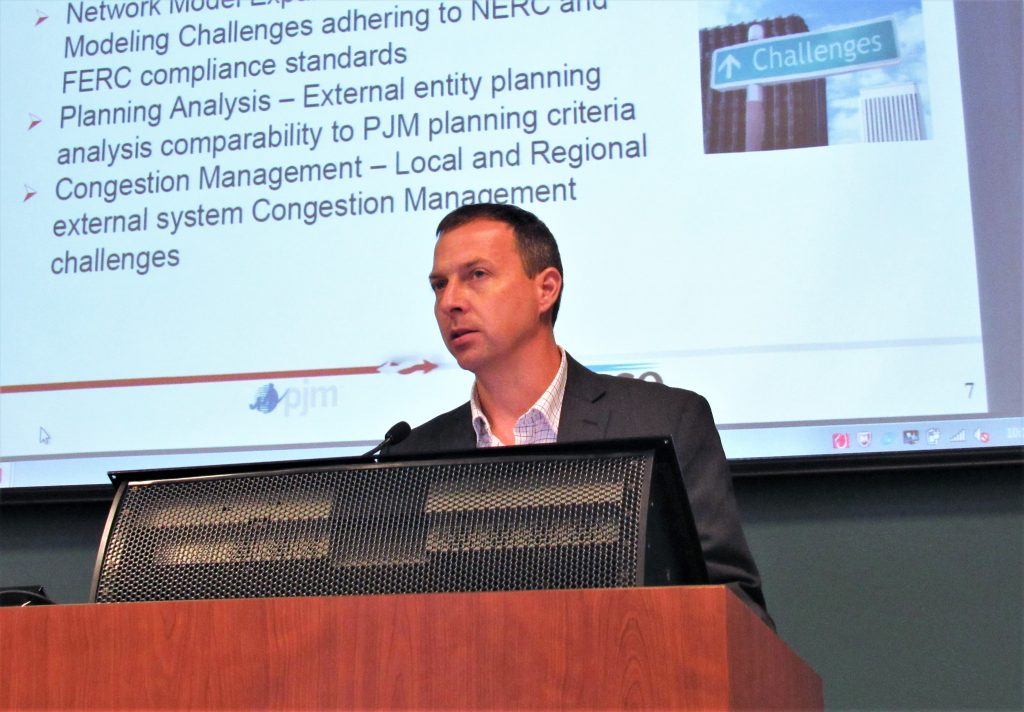By Amanda Durish Cook
CARMEL, Ind. — Both MISO and PJM will attempt second drafts of their respective pseudo-tie requirements after receiving deficiency letters from FERC in response to their initial filings, officials said Tuesday.
MISO Director of Forward Operations Planning Kevin Vannoy confirmed at a May 23 MISO-PJM Joint and Common Market meeting that the two RTOs are working to respond to FERC’s requests for more information.
“Both RTOs are making administrative improvements that were intended for this year, but the commission rejected those, so we are continuing with those filings and continuing to work through the congestion overlap issue,” Vannoy said.
FERC’s May 5 deficiency letter asked PJM to explain how much it worked with MISO on the rules, how its proposed minimum electrical distance impedance was determined and how it will determine whether resources are operationally deliverable (ER17-1138).
That followed FERC’s deficiency letter to MISO in April. (See FERC Seeks More Details on MISO Pseudo-Tie Proposal; “MISO, PJM in ‘General’ Agreement over Pseudo-Tie Congestion Remedy,” MISO Market Subcommittee Briefs.)
MISO Senior Director of Regional Operations David Zwergel said his RTO still agrees that a revised pseudo-tie agreement will allow it to manage pseudo-tie impacts reliably. “It’s not infinite; there’s only so many pseudo-ties that transmission can handle,” Zwergel added.
PJM proposed that pseudo-ties be based on aligned network models from the two RTOs for flowgates and have firm transmission subject to a deliverability analysis similar to one it uses for internal resources. The RTO also proposed that any new flowgate created because of a pseudo-tie must have at least one flexible internal generator with at least a 1.5% impact on the flowgate.
“None of the current pseudo-ties fail this [deliverability] test … so we’re okay so far with that,” said Tim Horger, PJM director of energy market operations. Horger said PJM will again take up deliverability test specifics once double-counting complaints from MISO and PJM market members are resolved. “Once the dust settles from the FERC filings, we’ll work on that. We took a historical look at impacts so far.”
Customized Energy Solutions’ David Sapper asked if the RTO with the most stringent pseudo-tie rules would essentially determine what requirements new and existing pseudo-ties would follow.
“I guess you could look at it that way, but both requirements are going to have to be met,” Horger replied.
Some stakeholders expressed concern that MISO and PJM are still pursuing stricter pseudo-tie rules considering they don’t always bind at the same time on constraints.
Sapper also asked for more detailed Tariff filings from the RTOs on the second pseudo-tie requirement attempts, saying that MISO’s load-serving entities prefer more details, especially because the filings are “uncharted territory.”
Horger also said PJM is still pushing for its first-ever pseudo-tie pro forma agreement, which was debated for months this year before it was put on hold. Horger said if the RTOs agree on future rules laid out in their joint operating agreement, MISO would no longer need to be a signatory to the pro forma, and it could be limited to pseudo-tie owners and PJM. Horger said MISO and PJM staff are currently at work on joint operating agreement language.
However, Horger said PJM still isn’t in a hurry to finalize a pro forma. “We have the whole FERC quorum issue also; I don’t think there’s a rush to get this filed,” he said. The commission has been without a quorum since February, preventing it from taking definitive action on any disputes, including addressing the MISO Independent Market Monitor’s challenge to the pseudo-tie concept. (See Pseudo-Tie Feud Rises as Patton, NYISO Protest PJM Proposal.)
RTOs Closer to Double-Congestion Rebate Program
MISO and PJM hope to implement rebates by September as a stopgap solution to the double-charging of congestion on pseudo-tied units.
The RTOs agree that day-ahead firm flow entitlement exchanges will improve predictions on the effect of congestion on pricing. The day-ahead exchanges between MISO and PJM began in late January.
Vannoy said in a best-case scenario, MISO and PJM can implement the stopgap rebate solution by the beginning of September and implement a longer-term goal of scheduling pseudo-ties in the day-ahead process by next May.
Four Categories for Freeze Date
Joe Rushing, a senior engineer in PJM’s interregional planning division, said the RTOs will continue to pursue a “bucket” approach to revise the current 2004 freeze date for determining eligibility for a share of firm rights on flowgates. The rights would be divvied up based on how long resources have participated in the market. (See “Freeze Date Future in Buckets?” PJM, MISO Go Quiet on Pseudo-Ties; Reach Interface Pricing Accord.)
The RTOs are proposing to add a fourth tranche to include market-wide transfers that align with planning processes. The tranche would be the first in line for a megawatt reduction when firm flow entitlements exceed a flowgate’s capability. The third tranche — which allows for entitlements to be granted for limited market-based transfers for reliability within the RTO balancing authority — will end after 10 years.
The first bucket will continue to be used for active designated network resources predating the current April 1, 2004, freeze date and historic transmission service requests, which will be given first consideration for flowgate needs. A second tranche would be for active designated network resources and transmission service requests after 2004.
Rushing said the RTOs will draft Tariff language for a FERC filing sometime in the third quarter.





